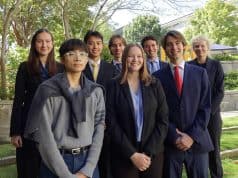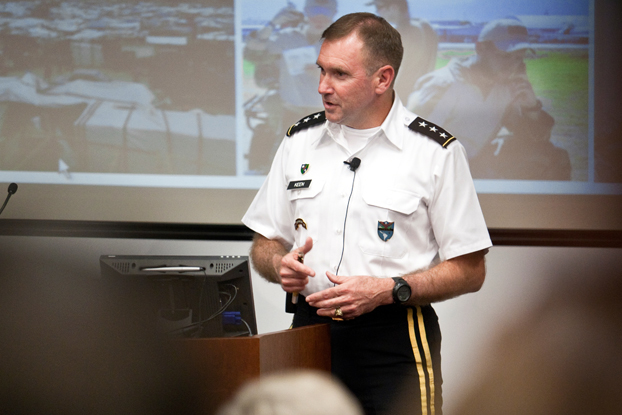Growing a business has never been easy. Today, it is particularly challenging.
The COVID-19 pandemic and the resulting economic crisis are rewriting the rules of business anew each day. What worked yesterday may not work today — or ever again. It is testing executive leadership and the strength of leaders’ past performance in creating a strong market orientation, a sound financial base, effective people-based processes and a culture of innovation, engagement and trust.
“This is not going to be a ‘flip-the-switch’ situation where we are suddenly back to where we were in late 2019,” said Nicola Barrett, chief corporate learning officer at Emory University’s Goizueta Business School. “It’s critical for leaders to think about how they are going to adapt to the next normal, and then the next normal after that.”
Smart leaders are rethinking, reimagining, and reinventing their businesses, Barrett said. “By taking stock of all of the tangible and intangible assets that you have and recombining them in a way that meets both the short-term survivability challenge with new and emerging business needs on which to build for the long term.”
Emory Executive Education, the unit Barrett leads at Goizueta, has focused on how businesses find and capture new sources of growth from the ideas, research and teaching of its faculty. While it may sound counterintuitive, now is the time to identify changes to your business model, potential new products and services and explore new market segments, Barrett said. This is about defining the next normal, not just adapting to what comes next.
The urgency for forward-focused change requires a high degree of organizational and individual agility and resilience. This has implications for several factors central to organizational success: leadership; strategy; a market orientation; complex problem solving and decision-making; and the ability to execute.
“Leadership starts with having a true understanding of your purpose and values, being willing to adapt and learn and inviting and inspiring others to do the same” says Barrett, expanding on statements made by Karl Kuhnert, professor in the practice of organization and management at Goizueta, in an article about becoming a competent leader.
When there is a high degree of uncertainty, top-down, hierarchical decision-making increases business risk. Organizations can’t flex quickly enough. According to Rick Gilkey, also a professor in the practice of organization and management at Goizueta. “as complexity accelerates, organizations don’t have people with all the answers.” Successful leaders provide an environment in which employees can thrive. Investing in people and cultivating a culture of innovation, in which ideas are encouraged and examined rigorously, increases the value of their knowledge and actions.
Kuhnert and Gilkey have identified common traits in successful leaders. They found mature, effective leaders think differently: they paint on a much larger canvas than less mature leaders. For example, either/or quandaries are replaced by both/and thinking. Closely associated with thinking like a leader are behaviors like:
- Staying curious.
- Continuously scanning, looking for weak signals.
- Identifying unconventional sources.
- Disconfirming information.
- Dissenting productively.
- Seeing patterns.
- Seeking opportunities, particularly in adversity or scarcity.
Opportunities emerge when leaders listen to existing and prospective customers through frontline employees, social media and other tools that help companies stay in sync with their suppliers and buyers’ interests, Barrett said. Robert Kazanjian, Asa Griggs Candler professor of organization and management at Goizueta, teaches that “strategy isn’t a once-and-done. You have to be constantly thinking about, talking to and understanding your stakeholders, where they are going, and the challenges they’re facing.”
In an article about anticipating market shifts and improving organizational agility, Kazanjian said that a company misses opportunities to grow when it only makes “small tweaks instead of big shifts” in its strategy. “They don’t revisit questions about where to compete and how to compete,” Kazanjian said. “Crises, for instance, require leaders to pay immediate attention to strategic choices for both short-term survival through cost reductions and to developing new revenue sources for long-term growth. It may be that existing trends and emerging practices are accelerated by crisis, requiring organizations to more quickly alter strategies and build new capabilities for the longer term.”
Leaders must challenge themselves to ask: will the business model used by their company be relevant tomorrow? Where are disruptors most likely to originate? Technology has elevated customers’ expectations while reducing barriers to entry. “Only a few years ago, the sale price of a taxi medallion was huge, but then, thanks to technology, anyone who had a car could effectively become a cab driver,” Barrett said, noting the success of disruptors like Uber and Lyft and the widespread adoption of these services by the public.
Businesses grow when they involve customers in the creation and delivery of value, said Steve Walton, a professor in the practice of information systems and operations management at Goizueta, in an article about creating, capturing, and delivering new growth. “[The future of business] will become even more customer-centric.” In other words, leaders need to think about how customers are using their products or services and identify ways to improve the value offered to them.
“You have new, nimble, technology-enabled companies that are coming in and disrupting the value chain of traditional industries. Business leaders have to be constantly mindful of where new competition may come from,” said Anandhi Bharadwaj, endowed chair in electronic commerce and professor of information systems, operations management at Goizueta.
“You have to think of an operating model that is conceived in the digital world and then how this spawns new growth opportunities,” said Bharadwaj. “Then, think about how to build the required operating model.”
Goizueta is following Bharadwaj’s principle – accelerated due to the pandemic, Barrett said. Faculty and administrators are using technology to deliver sophisticated digital learning experiences. “While in-person learning is great, technology-enabled learning can be highly engaging and effective if designed well.”
Technology, data, social issues, speed and avenues of information dissemination have changed how to reach, understand and deliver value to customers. Big data offers marketers a substantial opportunity to connect with current and prospective customers, segment and learn what each values, and predict their behavior over time.
Data can show how customers act at any point in their buying journey, from acquisition to retention to engagement. “This creates opportunities for marketers to interact with their customers and prospective customers more than they have in the past,” said David Schweidel, a professor of marketing at Goizueta, in an article about using big-data marketing initiatives to find new growth sources.
In many organizations the role of chief marketing officer is being replaced by that of a chief growth officer, said Barrett, and “new growth opportunities emerge at the intersection of disciplines like technology, marketing and finance.” Daniel McCarthy, assistant professor of marketing at Goizueta, recommends “leveraging individual-level transactional data using best-in-class marketing science models to predict what customers will do in the future, when they’re going to make their purchases, how much they’ll spend, and how much of that spend will be retained as profit.”
Analyses like this can be directly linked to company valuations. According to Kristy Towry, John and Lucy Cook Chair and professor of accounting at Goizueta, in an article about modern managerial accounting practices, “accounting and finance cannot be a silent part of an organization. Accountants are experts in measurement and should be working across functions using forward-looking accounting skills to inform strategic decisions and help execute them effectively via good measurements and controls.”
Barrett believes that “surviving and thriving through this current global crisis not only relies on how well we have managed our organizations in the past, how adaptive we are as leaders, our strategic agility, and rigorous decision-making capability but on the culture and people practices we have in place.” Regardless of whether you are in accounting, finance, marketing, sales, strategic planning, IT or operations, ensuring your people are operating optimally is critical for your organization to operate at its full potential.
It’s also important to take note of the research into the physiology of decision-making and the impact of stress on executive functioning, productivity and performance. “Several of our faculty have research in this area, and now, more than ever, it is critical for leaders to be aware of how they and their team members are functioning mentally, emotionally and physically and how this impacts performance,” said Barrett. Citing Walton, Barrett pointed out that “when business operations are optimized through people who are doing their jobs well, better decisions are made, better data is collected, and better technologies and processes are implemented.”
Though the future is unclear, leaders must continuously learn and adapt to grow their businesses today and tomorrow. “The best leaders, as they evolve in their careers, realize they don’t have all the answers and that the way they did things yesterday may not be the best way to do them tomorrow,” Barrett said. “This pandemic has accelerated the pace at which leaders have to consider and lay the foundations for the next phase of their organizations.”
“Growth is about finding and capturing new opportunities by continually looking at your business in a new light and truly understanding your customers. We are going to have to rethink and reimagine what business and our organizations are going to be like in the next normal, however long that may be,” Barrett said. “Our goal in executive education at Goizueta Business School is to help leaders do just that by equipping them with the mindset, skill sets, and tool sets they need to be effective for their organizations.”
If you’d like to learn how you or your organization can engage with Goizueta faculty on this topic, speak with a learning advisor at 404-727-2200 or visit our website.
Emory University’s Goizueta Business School was created in 1919 as one of the nation’s first business schools. Its degree and Executive Education programs consistently rank in the top 25 in the world among major publications including Businessweek, The Economist, U.S. News & World Report, and Forbes.











